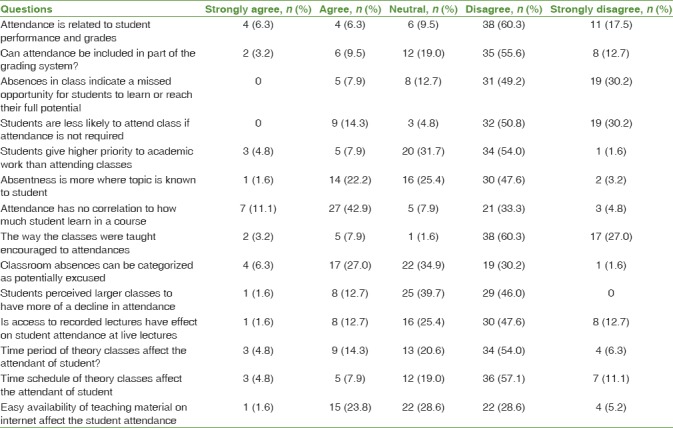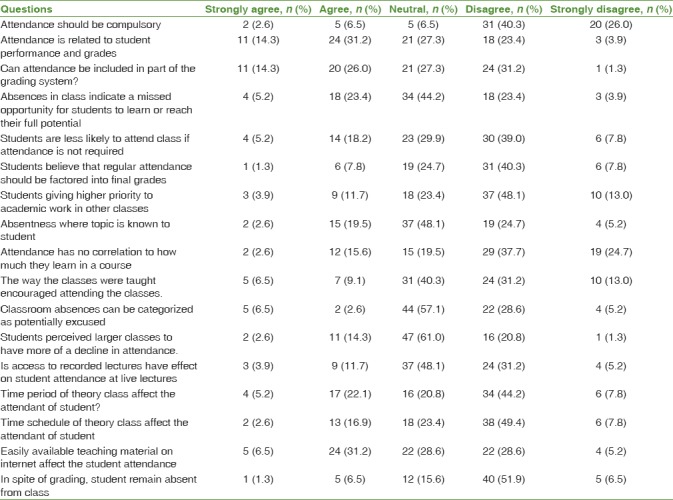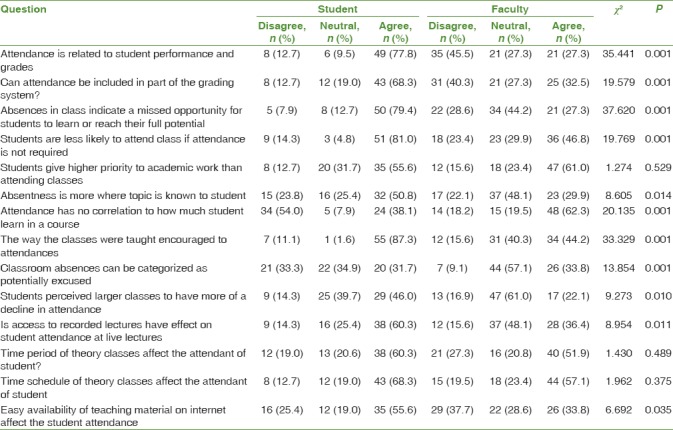Abstract
AIM:
The aim of this study was to assess the impact of lecture attendance on the academic performance of 3rd BDS students at the DMIMS-U, Sawangi (M), Wardha. This project investigated and correlated the difference between faculty and student perceptions regarding attendance and final performance, including factors thought to influence student attendance.
MATERIALS AND METHODS:
Participants from a single university were included in the present retrospective observational study. The study was conducted in April 2016; 77 3rd BDS students (2012 Batch) and teaching staff of SPDC willing to voluntarily participate were included and divided into two groups such as Group A and Group B. Student and faculty perceptions were obtained using Likert scale having 15 closed-ended and 3 open-ended questions. Questioner was made related to factors affecting the attendance in class, type of source available for study, awareness about topic, and faculty approach. Comparison between perception of students and faculty regarding attendance and final performance was done using Mann–Whitney U-test. P < 0.05 was considered statistically significant.
RESULTS:
Quantitative analyses revealed significant differences between faculty and student perceptions on most of the project variables. Qualitative analyses reinforced those findings and suggested that faculty misunderstood what factors actually influence student attendance. The results suggest that there is a substantial disconnect between faculty and student perceptions regarding the importance of class attendance and highlighted areas for faculty to influence student attendance.
CONCLUSION:
Motivation is the major factor causing students to attend the lectures. Unfortunately, not all students are motivated to study and learn. New styles of teaching may need to be looked into. This needs to be further investigated on large sample size.
Keywords: Attendance, faculty-student differences, final performance, perceptions
Introduction
When substantial number of students does not attend, classroom learning is depreciated, student and teacher morale suffer, and academic standards are compromised.[1] Student classroom attendances are a popular topic of both empirical research and faculty discussions.[2,3,4,5] Both the research and the discussions focus on the central question: Why do not students attend every class? Although faculty perceptions are based on their own idiosyncratic experiences in the classroom, those perceptions are validated for the present study.
As educators, many university faculties are rightfully concerned about student absences since substantial empirical research, and their own experiences have demonstrated that attendance is related to student performance and grades, even in courses where attendance is not a part of the grading system.[6,7] Marburger in 2001 documented that missing a class period increased the probability of responding incorrectly to an examination question.[8]
Evidence of the factors that influence student attendance supports this common perspective. Students are more likely to attend class: if they consider the material or instructor interesting,[4] if in-class quizzes are announced,[9] if attendance is required for their grade, and if there are direct consequences for absenteeism.[2,3,4] Students are less likely to attend class if attendance is not required, especially later in the semester;[9,10] if they are assigned to larger classrooms versus smaller classroom settings, where they perceive their absence will not be as noticeable;[2,8] if they perceive a negative effect on their attendance likelihood if given full notes for the class period by the instructor;[11] or if they believe that regular attendance should be factored in to final grades.[12] Moore et al. in 2008 reported that only 17% of students’ classroom absences can be categorized as potentially excused (e.g., medical emergencies); 23% were related to giving higher priority to academic work in other classes (e.g., cutting class to study for another test), and 60% were related to low intrinsic motivation (e.g., too tired and class is boring).[13] Potential reasons suggested for this pattern were course level, course size, and five specific student perceptions.
These perceptions are that students believe: (a) nothing important will be covered during that period; (b) no effort is required before studying for the next examination; (c) class attendance will not affect their final grades, especially in classes where attendance is not recorded; (d) missing this particular class will not change their grade on their next test; and (e) attendance has no correlation to how much they learn in a course. According to the literature reviewed above, all of these misperceptions are common.[5]
The reasons that many faculties are concerned about this absenteeism are threefold. First, it is a symptom of larger absenteeism throughout the course, which prior research has documented leads to poor academic performance. Second, because of their awareness of the connection between attendance and performance, many faculties expend considerable time and effort attempting to increase student attendance to maximize student success. Third, specifically related to these unique class periods, many faculties use those course periods to either review examinations or introduce the foundation for new units in the course. Both of those uses can disproportionately influence student learning in the course in comparison to many other course days, so absenteeism on those days can pose an even greater threat to student learning.[14]
Class attendance has long been subject of debates while measuring performance in examinations. Faculty has own perception, and student has their own perception regarding important of attendance for performance in final examination. Attendance at classes has traditionally been thought to be a prerequisite to good academic performance. Some studies have shown that there is a positive correlation between attendance and academic performance. Khan et al. have shown that there is a positive correlation between attendance and academic performance. In addition, several sources show a relatively consistent relationship between attendance and grades, regardless of the course subject or level of student. It is not only the improved the final result but knowledge and skill is also directly depends on learners presence in class, practical or clinic.[15,16,17]
It is argued that attendance policy goes beyond just “filling seats,” by mandating student–faculty interactions which are a critical aspect to facilitate learning.[18] The determination of students’ academic performance is an important issue in medical profession. Proponents advocate that there is a direct relationship between these two variables and there has been prolific literature in this direction. The study was done to assess the impact of lecture attendance on the academic performance.[19]
Materials and Methods
The retrospective observational study was conducted in the year of 2016, after obtaining the prior approval from the Institutional Ethical Committee (DMIMS (DU)/IEC/2016-17/1530-A).
Sample size
Seventy-seven 3rd BDS students (2012 Batch) and teaching staff of SPDC willing to voluntarily participate in the study.
Group A
Student perception was obtained using Likert scale having 15 closed-ended and 3 open-ended questions.
Group B
Dental faculty perception was obtained using Likert scale having 17 closed-ended and 4 open-ended questions.
Inclusion criteria
All students of 3rd BDS (2012 Batch) willing to voluntarily participate were included in the study.
Exclusion criteria
Students who were absent or not willing to voluntarily participate were excluded from the study.
Duration of study
The total study duration was 6 months.
This project investigated and correlated the difference between faculty and student perceptions regarding attendance and final performance, including factors thought to influence student attendance. Informed consent was taken from all 80 students of 3rd BDS students and teaching staff enrolled for this study.
Student perception regarding relation of attendance with performance was obtained using Likert scale; perception questionnaire consists of 14 closed-ended and 3 open-ended questions, and perception of dental faculty regarding correlation of attendance with performance was also obtained on Likert scale having 17 closed-ended and 4 open-ended questions.
Data analysis was done to find out the relation between student and faculty perceptions regarding attendance and final performance. Comparison between perception of students and faculty regarding attendance and final performance was done using Mann–Whitney U-test. P < 0.05 was considered statistically significant.
Results and Observation
All the data are collected from student and faculty and tabulated in Tables 1 and 2. Comparison between perception of students and faculty regarding attendance and final performance was done using Mann–Whitney U-test. P < 0.05 was considered as statistically significant and tabulated in Table 3.
Table 1.
Various comments for open-ended items given by students

Table 2.
Various comments for open-ended items given by faculty

Table 3.
Students perception regarding attendance and final performance

A total of 14 questions were asked to student and faculty; after data analysis, we found that for most of question that there is significant difference between student and faculty aspect for 4–5 questions.
Analysis of open-ended questions
Responses to open-ended questions were analyzed qualitatively. Table 1
Discussion
Literature suggests that attendance and academic performance are directly correlated, with some studies showing a relatively consistent relationship regardless of the course subject or level of student.[15,17] This study shows that there is no correlation between attendance of student and final results. Finding from cohort as a whole and also mention that there is no direct correlation was seen between lecture attendance and final mark or result.[20] The pattern of lecture attendance was similar for students in all grade ranges, but passing students were more likely to supplement attendance at lectures with the use of recordings.[20] In addition to some studies showing that attendance and academic performance are directly correlated, some studies show a relatively consistent relationship between attendance and grades, regardless of the course subject or level of student.[21,22]
In the present study, 43% of faculty believe that attendance and academic performances are directly correlated, while only 20.8% of students are agree, showing significant differences between perception of students and faculty with P = 0.001. The Faculty of Medical Sciences at UWI, Cave Hill, has an attendance policy which states that “students must have an attendance rate of 80% of all timetabled sessions to sit final course examinations” (UWI, 2009).[23]
Forty-five present of faculty believes that attendance should be included as a part of grading while only 20% of students are agree with this, showing significant differences between perception of students and faculty with P = 0.001.
This study supports prior research that students and faculty have different perceptions about class attendance and participation. Students believe that attendance should be part of their course grade because it is fair to reward those who come to class and participate.[24]
Khan et al. have shown that there is a positive correlation between attendance and academic performance.[16] However, they also found that 21% of students who had very low attendance were in the top 20% in their class. Most of the study shows that confounding factors in the learning process, such as student motivation and levels of engagement, which may have a greater contribution to academic performance than attendance. Studies conducted by Le Blanc, in year 2005 showing that attendance and academic performance are directly correlated [Table 4], some studies show a relatively consistent relationship between attendance and grades, regardless of the course subject or level of student.[21]
Table 4.
Faculty perception regarding attendance and final performance

Twenty-seven percentage of the student believe that easy availability of the teaching material at internet affects the attendance in classroom, while 38% of faculty member mention that easy availability of the teaching material is one of the common causes for not attending the class, with significant differences between perception of students and faculty with P = 0.019. In general, access to recorded lectures has little to no effect on student attendance at live lectures.[20,25] However, some studies have found that recorded lectures do seem to have a slight negative effect on lecture attendance [Table 5].[26] Besides student-related factors, the effect of other factors, particularly classroom and teaching-related ones, should be considered in the analysis of student attendance and academic performance.
Table 5.
Correlation of students and faculty perception regarding attendance and final performance

The results of present study from the overall data analysis indicate that attendance, even though critical to the learning process, is not the single most important factor in the learning process and suggest that other factors are critical to academic success [Table 6]. The study conducted by Cohall and Skeete in the year 2012 also feverous the same finding.[27]
Table 6.
Comparison of student attendance and final result

Besides student-related factors, the effect of other factors, particularly classroom and teaching-related ones, should be considered in the analysis of student attendance and academic performance. Some of these factors may be well indicated in the holistic approach which is regarded as the best approach to the learning process. Cohall in 2009 and Patel in 2003 also suggest that holistic approach is one of the effective approaches for learning.[23,28]
Conclusion
In the present study, we found that there is significant difference between perception of faculty and students regarding attendance, although there is positive correlation between class attendance and examination results.
Following important aspects of student behavior in relation to attendance were identified. Motivation is the major factor causing students to attend the lectures. Unfortunately, not all students are motivated to study and learn. Results indicated that some students found lectures boring and not worth attending. New styles of teaching may need to be looked into. This needs to be further investigated on large sample size.
Financial support and sponsorship
Nil.
Conflicts of interest
There are no conflicts of interest.
Acknowledgment
We are very much thankful to Dean Dr. A. J. Pakhan sir, Vice-chancellor Dr. R. M. Borle sir and Registrar Dr. Anjankar sir, for providing all the facilities to complete the project. We are also thankful to our statistician Dr. Roshani Chawla. We are very much thankful to Dr. Jimmy Sangtani for her support in preparation of manuscript. Ethical moral code DMIMS (DU)/IEC/2016-17/1530-A.
References
- 1.Brown W. Why I don’t let students cut my classes. In: Gordon V, Minnick T, editors. Foundations: A Reader for New College Students. Belmont, CA: Wadsworth; 2002. pp. 100–10. [Google Scholar]
- 2.Friedman P, Rodriguez F, McComb J. Why students do and do not attend classes: Myths and realities. Coll Teach. 2001;49:124–33. [Google Scholar]
- 3.Gump SE. Keep students coming by keeping them interested: Motivators for class attendance. Coll Stud J. 2004;38:157–60. [Google Scholar]
- 4.Ajiboye JO, Tella A. Class attendance and gender effects on undergraduate students’ achievement in a social studies course in Botswana. Essays iEduc. 2006;18:1–14. [Google Scholar]
- 5.Much_Metta. Decline in Attendance after Exam [Msg 1]. Message Posted to. [Last accessed on 2008 May 28]. Available from: http://www.chronicle.com/forums/ index.php/topic,47686.msg844155.html#msg844155 .
- 6.Brewer EW, Burgess DN. Professor's role in motivating students to attend class. J Ind Teach Educ. 2005;42:23–47. [Google Scholar]
- 7.Gump SE. The cost of cutting class: Attendance as a predictor of student success. Coll Teach. 2005;53:21–6. [Google Scholar]
- 8.Marburger DR. Absenteeism and undergraduate exam performance. J Econ Educ. 2001;32:99–109. [Google Scholar]
- 9.Azorlosa JL, Renner CH. The effect of announced quizzes on exam performance. J Instr Psychol. 2006;33:278–83. [Google Scholar]
- 10.Marburger DR. Does mandatory attendance improve student performance? J Econ Educ. 2006;37:148–55. [Google Scholar]
- 11.Cornelius TL, Owen-DeSchryver J. Differential effects of full and partial notes on learning outcomes and attendance. Teach Psychol. 2008;35:6–12. [Google Scholar]
- 12.Hassel H, Lourey J. The dearth of student responsibility. Coll Teach. 2005;53:2–13. [Google Scholar]
- 13.Moore S, Armstrong C, Pearson J. Lecture absenteeism among students in higher education: A valuable route to understanding student motivation. J High Educ Policy Manage. 2008;30:15–24. [Google Scholar]
- 14.Maurer TW, Frost L, Sturges D, Charls S, Allen D, Chawthom M, et al. Faculty and student perceptions of post-exam attendance. J Scholarsh Teach Learn. 2009;9:38–55. [Google Scholar]
- 15.Ali N, Jusoff K, Ali S, Mokhtar N, Salamat AS. The factors influencing students’ performance at Universiti Teknologi MARA Kedah, Malaysia. Manage Sci Eng. 2009;3:81–90. [Google Scholar]
- 16.Khan HU, Khattak AM, Mahsud IU, Munir A, Ali S, Khan MH. Impact of class attendance upon examination results of students in basic medical sciences. J Ayub Med Coll Abbottabad. 2003;15:56–8. [PubMed] [Google Scholar]
- 17.Shimoff E, Catania AC. Effects of recording attendance on grades in introductory psychology. Teach Psychol. 2001;28:192–5. [Google Scholar]
- 18.Carnegie Foundation. Reinventing Undergraduate Education: A Blueprint for America's Research Universities. Stony Brook: State University of New York at Stony Brook; 8 Reinventing Undergraduate Education: A Blueprint for America's Research Universities Stony Brook: State University of New York at Stony Brook; 1998. [Google Scholar]
- 19.Crede M, Roch SG, Kieszczynka UM. Class attendance in college: A meta-analytic review of the relationship of class attendance with grades and student characteristics. Rev Educ Res. 2010;80:272–95. [Google Scholar]
- 20.Von Konsky B, Lvins J, Gribble S. Lecture attendance and web based lecture technologies: Comparison of students perception and usage pattern. Australas J Educ Technol. 2009;25:581–95. [Google Scholar]
- 21.Le Blanc HT. The Relationship between Attendance and Grades in the College Classroom. Paper Presented at the 17th Annual Meeting of the International Academy of Business Disciplines, Pittsburgh, Pennsylvania. [Last accessed on 2005 Apr 08]. Available from: http://www. communication.utsa.edu/leblanc/articles/art31.pdf .
- 22.Kirby A, McElroy B. The effect of attendance on grade for first year economics students in University College Cork. Econ Soc Rev. 2003;34:311–26. [Google Scholar]
- 23.Cohall DH. Faculty of Medical Sciences. Cave Hill, Barbados: The University of the West Indies; 2009. Course outline for Fundamentals of Disease and Treatment. [Google Scholar]
- 24.Higbee JL. Attendance policies in developmental education courses: The student point of view. Res Teach Dev Educ. 2006;23:78–85. [Google Scholar]
- 25.Holbrook J, Dupont C. Profcasts and Class Attendance – Does Year in Program Matter? Bioscience Education. 2009. [Last accessed on 2015 Jun 06]. p. 15. Available from: http://www.bioscience.heacademy.ac.uk/journal/vol13/ beej-13-c2.pdf .
- 26.Gorissen P, Van Bruggen J, Jochems W. Students and recorded lectures: Survey on current use and demands for higher education. Res Learn Technol. 2012;20:143–53. [Google Scholar]
- 27.Cohall DH, Skeete D. The impact of an attendance policy on the academic performance of first year medical students taking the fundamentals of disease and treatment course. Caribb Teach Scholar. 2012;2:115–23. [Google Scholar]
- 28.Patel NV. A holistic approach to learning and teaching interaction: Factors in the development of critical learners. Int J Educ Manage. 2003;17:272–84. [Google Scholar]


